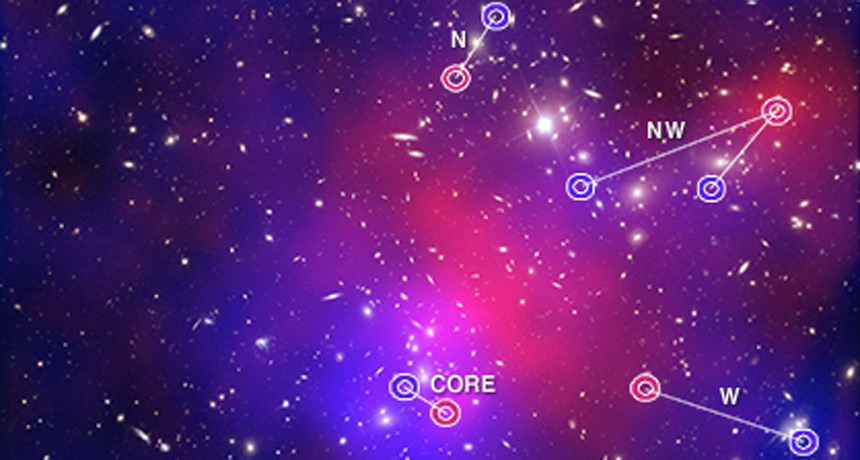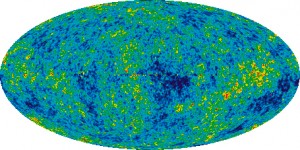The dark side of the universe
Most of the cosmos is invisible, but that doesn’t stop scientists from searching for it

The "core" region shows a bullet-shaped structure in the hot gas and a separation between the hot gas and the dark matter here in this image of colliding galaxy clusters known as Abell 2744.
X-ray: NASA/CXC/ITA/INAF/J.Merten et al, Lensing: NASA/STScI; NAOJ/Subaru; ESO/VLT, Optical: NASA/STScI/R.Dupke
Share this:
- Share via email (Opens in new window) Email
- Click to share on Facebook (Opens in new window) Facebook
- Click to share on X (Opens in new window) X
- Click to share on Pinterest (Opens in new window) Pinterest
- Click to share on Reddit (Opens in new window) Reddit
- Share to Google Classroom (Opens in new window) Google Classroom
- Click to print (Opens in new window) Print

If seeing is believing, then we shouldn’t believe in most of our universe.
We can see the sun, other stars and faraway objects that glow in the dark. With the right tools, we can even see things that would otherwise be invisible, like the air in the atmosphere or hot gas in distant galaxies.
Astronomer Carl Sagan liked to say, “We are made of star stuff.” He meant that everything we know — you and your dog, the Earth and moon — is made of the same kinds of atoms as glittering stars. These atoms form elements like carbon, hydrogen, nitrogen, oxygen and hundreds more.
In recent years, astronomers have shown that “star stuff” isn’t the only stuff in the universe. There’s something else moving galaxies around in unexpected ways. That something else includes dark matter and dark energy. Even though these two things are hidden from sight, or “dark,” they’re very different from each other. Because scientists cannot observe dark matter and dark energy directly, they have to study how dark energy and dark matter affect celestial objects we can see — visible stars and galaxies.
Dark energy makes up most of the universe. Dark matter comes in second. And our familiar star stuff — including Earth and everything on it — is less than 5 percent of the universe. Five percent is not much — it’s a little less than three colored squares on a Rubik’s Cube, or equivalent to a very small ice cube in a tall glass of water. It’s a humbling thought.

These percentages have inspired one of the greatest mysteries of modern science: What is our universe? What’s out there, besides the kinds of atoms we know about? Around the world, physicists are racing to discover dark matter particles and learn more about dark energy. Researchers are conducting experiments in laboratories buried deep underground and taking measurements with powerful telescopes that fly through space.
The universal glue
Gravity is an attractive force, which means it brings objects together. The more mass something has, the more gravity, or pull, there is. Because of gravity, the Earth repeatedly circles the sun instead of flying away. And gravity allowed scientists to discover dark matter.
Swiss astronomer Fritz Zwicky stumbled across dark matter in 1933. He was attempting to tally the total mass of a distant galaxy cluster, a family of galaxies held together by gravity. But his numbers just weren’t adding up. To understand Zwicky’s problem, imagine that you want to know the weight of 10 oranges, and each orange weighs one pound. You guess the weight should be 10 pounds, but when you pile the oranges on a scale, it tells you the weight is 100 pounds, not 10.
That was Zwicky’s problem. When he calculated the mass of the galaxy cluster on the basis of its stars, that number that was way too small to explain the cluster’s gravity. Some mass must be missing, he reasoned. Zwicky called the unseen mass dark matter.

Over time, more evidence for dark matter would emerge. In the 1970s, for instance, astronomers observed galaxies spinning in unexpected ways. Their strange motions could be explained only by dark matter.
Astronomer Dan Coe studies dark matter at the Space Telescope Science Institute in Baltimore, Md. He recently led a study of a galaxy cluster called Abell 1689. Both the visible galaxies and dark matter add to the gravitational pull in a cluster. These gravitational forces act like a lens, and when light passes through a cluster like Abell 1689, it bends. (Think of how light changes when it passes through an empty glass or a pool of water.) By studying these bending light rays, Coe and his team created a map of Abell 1689 that shows where the dark matter might be hiding in the cluster.
Accepting the existence of dark matter would solve many apparent problems related to the study of the universe.
But a major problem remains: Scientists have been unable to find the actual particles that make up dark matter. Researchers have ideas and they can design experiments to test those ideas. But so far, the hunt for dark matter particles has been a process of elimination: Experiments have only been able to rule out possible candidates, not find them.
“They’re very elusive,” concedes astronomer Wendy Freedman, director of the Observatories of the Carnegie Institution in Pasadena, Calif. “Astronomers hope [dark matter particles] will be discovered in the next decade.”
A river runs through you
Hold still. Did you feel that?
Billions of tiny dark matter particles probably just zoomed through your body. They were moving fast — about 560,000 miles per hour. There go billions more. And more still. They’re zipping everywhere, streaming through everything you can see.
Yet we don’t feel these particles. We can’t see them. And we can’t stop them. They blow through atoms like they’re not even there. Unlike the atoms that make up star stuff, dark matter particles don’t reflect light, and they don’t respond to electricity or magnetism.
Scientists have come up with many ideas to explain dark matter, and then they come up with ways to search for dark matter particles. As researchers conduct experiments and do tests, many of these ideas get ruled out.
One possible particle, for example, was called a neutrino. Even though scientists can find evidence for neutrinos, they quickly discovered that neutrinos can’t form big enough clumps to be the missing mass. So neutrinos won’t solve the mysteries of dark matter.
A particle that has not been ruled out is a neutralino. It is a WIMP, which stands for weakly interacting massive particle. This means it has some mass, but it only rarely plays with other kinds of particles. Many scientists believe WIMPs are our best bet for a dark matter particle.
Recently, scientists have been looking for WIMPs in powerful beams of gamma rays, which are essentially high-energy X-rays. When two WIMPs collide, they might destroy each other and unleash gamma rays — so some scientists believe that gamma rays may “point” back to the WIMPs.
Other researchers are looking for WIMPs underground. Even though these particles are weakly interacting, they should smash into the nucleus of an ordinary atom now and then. Many dark matter experiments have been set up to scout for these collisions. The experiments are conducted underground to avoid contamination by other particles.
In the absence of proof of dark matter particles, some researchers have challenged the existence of dark matter. One alternate theory, for example, suggests that at the scale of the universe, gravity may follow different rules than it does on Earth. In this case, maybe what scientists see as dark matter is really just gravity acting in a different way.
The opposite of gravity
Dark matter holds things together. Dark energy, on the other hand, sends things flying apart. It’s like the opposite of gravity.
Astronomers discovered dark energy by viewing the explosions that flare up when a star runs out of fuel and dies. That bright explosion, known as a supernova, helps scientists estimate the age of the universe.
Since the Big Bang, the universe has been expanding, which means most galaxies are moving farther away from each other. (Just as if you mark two dots very close together on a deflated balloon and start blowing it up, those two dots move apart.) Imagine you’re on one dot, looking at another. That other dot gets farther and farther way. But if you can figure out how far away it is and how fast it’s moving, then you can figure out when your dot and the other dot were right next to each other. This calculation is like running a film in reverse.
Scientists use different kinds of bright spots in the universe, including supernovas, for this calculation. In the 1990s, scientists measuring the age of the universe through studies of supernovas became puzzled by their results. The locations and speeds of the supernovas showed that the universe was younger than the Milky Way, our galaxy. But that is impossible: You can’t have a galaxy unless you have a universe to hold it.
Or, as Wendy Freedman says, “you can’t have a child that’s older than its parent.”
The solution to the problem was stranger than anyone had imagined. Scientists worked on experiments that in 1998 showed that the pace of the universal expansion was speeding up. This acceleration explains why those supernovas appeared too far away. They had somehow gotten some boost.
“Dark energy is stretching the universe apart,” says Freedman, who has been studying dark energy and supernovas for the last nine years. She says that with gravity, if you jump off a cliff, you know you’re going down. “But with dark energy, when you get to the edge of that cliff, you go up.”
Dark energy is believed to be very weak. It has a tiny effect on small things. But because dark energy is everywhere in the universe, these tiny bits of dark energy collectively add up to a powerful force that is strong enough to overcome the gravity from both dark matter and ordinary matter.
Dark energy remains one of the biggest mysteries of the universe. Evalyn Gates, director of the Cleveland Museum of Natural History, thinks that one day people will understand dark energy — or whatever it turns out to be — and it will change the way we think about the universe.
“There’s a way to understand [dark energy], but it’s going to take some creative new theory or understanding to get there,” she says. “It could be 10 years, it could be 110 years.” And when that understanding emerges, Gates says, “it’s going to completely revolutionize the way we think about space, time and matter.”
POWER WORDS
cosmology The study of the creation, structure and actions of the universe and its constituent parts.
astronomy The scientific study of matter in outer space, especially the positions, dimensions, distribution, motion, composition, energy and evolution of celestial bodies and phenomena. Astronomers are the scientists who study this field.
dark matter Physical objects or particles that emit little or no detectable radiation of their own and are believed to exist because of unexplained gravitational forces that they appear to exert on other astronomical objects.
dark energy Energy that appears to drive an acceleration in the expansion of the universe.
supernova A rare celestial phenomenon involving the explosion that ejects most of the material from a star, resulting in an extremely bright, short-lived object that emits vast amounts of energy.
galaxy Any of numerous large-scale groups of stars, gas, and dust that populate the universe, each containing an average mass equal to 100 billion (1011) of our suns and ranging in diameter from 1,500 to 300,000 light-years. (A light-year is a unit of distance equal to how far light will travel in one year.)
radiation Energy that is carried by waves through space. Heat, light, electricity and streams of radioactive particles are all forms of radiation.
atom The basic unit of an element. Atoms have a nucleus of protons and neutrons, and electrons circle the nucleus.
gravity The force that attracts any body with mass toward any other body with mass. The more mass there is, the more gravity there is.
mass The amount of matter in an object.






